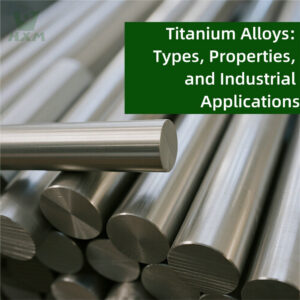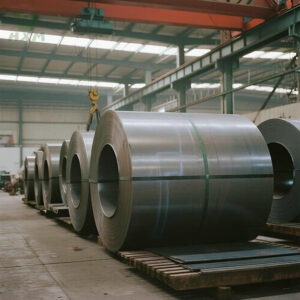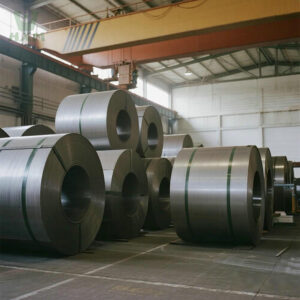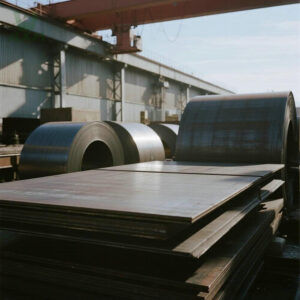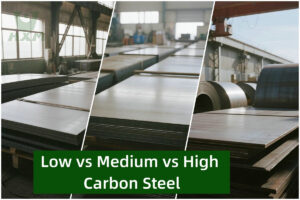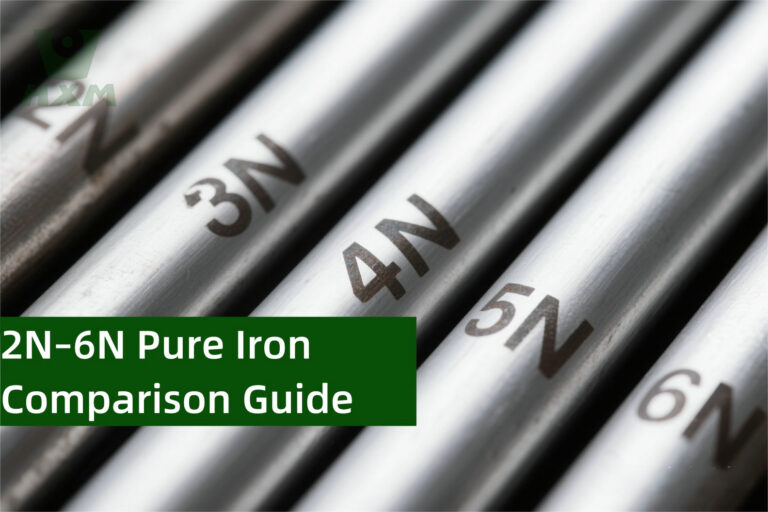
Pure iron is classified by purity levels, ranging from industrial grades (2N–3N, Fe ≥ 99.0–99.9%) to high purity (4N, Fe ≥ 99.99%), and finally ultra high purity (5N–6N, Fe ≥ 99.999–99.9999%).
The difference lies not only in the iron content but also in impurity control, gas content (O/N/H), and applications. This guide provides a complete comparison of 2N–6N pure iron, helping engineers, buyers, and researchers select the right grade.
1. Purity Grades Explained - 2N–6N Pure Iron
2N Pure Iron (Fe ≥ 99.0%) – Industrial-grade, suitable for metallurgy and alloy making
3N Pure Iron (Fe ≥ 99.9%) – Higher quality for chemical and magnetic applications
4N Pure Iron (Fe ≥ 99.99%) – High-purity iron for electronics and magnetic shielding
5N Pure Iron (Fe ≥ 99.999%) – Ultra high purity for semiconductor and PVD industries
6N Pure Iron (Fe ≥ 99.9999%) – Extreme purity for advanced research and nanotechnology
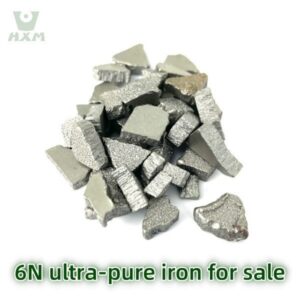
Ultra High Purity Iron (5N–6N Grade)
Huaxiao-Alloy is an ultra high purity iron supplier (5N–6N grade, Fe ≥ 99.999%–99.9999%) with ingots, foils, wires, rods, powders, granules, and sputtering targets.
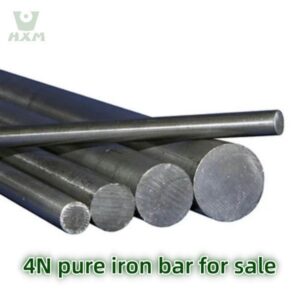
Huaxiao-Alloy is a high purity iron (4N grade, Fe ≥ 99.99%) supplier provides with ingots, foils, wires, bars, plates, strips, granules, and sputtering targets.
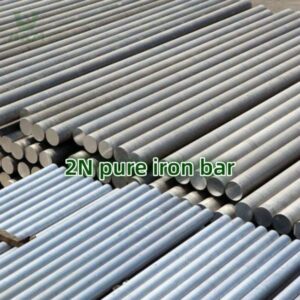
Industrial Pure Iron (2N–3N Grade)
Home Industrial Pure Iron Supplier (2N–3N Grade) Industrial Pure Iron (2N–3N grade) is a high-quality ferrous material with an iron content between 99.0% and 99.9%.
2. Chemical Composition Comparison (Reference Values, ppm) of 2N–6N Pure Iron
| Grade | Fe (min, %) | C (max) | S (max) | P (max) | Si (max) | Mn (max) | O (max) | N (max) | H (max) | Other elements |
|---|---|---|---|---|---|---|---|---|---|---|
| 2N | ≥ 99.0 | ≤ 200 | ≤ 200 | ≤ 200 | ≤ 500 | ≤ 500 | As-produced | As-produced | – | Balance ≤ 0.1% |
| 3N | ≥ 99.9 | ≤ 100 | ≤ 100 | ≤ 100 | ≤ 200 | ≤ 200 | ≤ 300 | ≤ 100 | ≤ 10 | Each ≤ 0.05% |
| 4N | ≥ 99.99 | ≤ 20 | ≤ 10 | ≤ 10 | ≤ 20 | ≤ 20 | ≤ 100 | ≤ 30 | ≤ 5 | Each ≤ 10–20 ppm |
| 5N | ≥ 99.999 | ≤ 10 | ≤ 5 | ≤ 5 | ≤ 10 | ≤ 10 | ≤ 20 | ≤ 10 | ≤ 3 | Each ≤ 5–10 ppm |
| 6N | ≥ 99.9999 | ≤ 2 | ≤ 1 | ≤ 1 | ≤ 2 | ≤ 2 | ≤ 5 | ≤ 3 | ≤ 1 | Each ≤ 1–2 ppm |
(Exact values depend on production process and customer requirements; COA provided for each batch.)
3. Physical & Magnetic Properties of 2N–6N Pure Iron
Density: ~7.87 g/cm³
Melting point: 1538 °C
Curie temperature: ~770 °C (ferromagnetic below this point)
Magnetic properties:
2N–3N: General magnetic performance, suitable for industrial use
4N: High permeability, low coercivity, suitable for shielding and electronics
5N–6N: Ultra-stable magnetic response, used in sensitive scientific and semiconductor applications
4. Applications by 2N–6N Pure Iron Grade
| Grade | Main Applications | Typical Industries |
|---|---|---|
| 2N | Base for alloy making, metallurgy feedstock | Steelmaking, foundry, chemical industry |
| 3N | Chemical reagents, catalyst carriers, general magnetic parts | Chemical processing, general electronics |
| 4N | Magnetic shielding, relay parts, precision cores | Electronics, sensors, magnetic materials |
| 5N | Sputtering targets, evaporation sources, high-end shielding | Semiconductor, thin-film coating, aerospace |
| 6N | Analytical standards, nanotechnology, experimental metallurgy | Research labs, advanced R&D, semiconductor fabs |
5. Supply Forms Comparison of 2N–6N Pure Iron
2N–3N (Industrial Pure Iron): Ingots, plates, bars, wires, granules (bulk supply)
4N (High Purity Iron): Ingots, foils, strips, wires, sputtering targets (clean packaging)
5N–6N (Ultra High Purity Iron): Foils, wires, powders, shots, sputtering/evaporation targets (cleanroom packaging, sub-ppm certification)
6. Summary
2N–3N: Cost-effective, for metallurgy and general industry
4N: High-purity, for electronics and magnetic shielding
5N–6N: Ultra-pure, for semiconductors, PVD, and research
Huaxiao-Alloy provides full range pure iron materials (2N–6N) with global export capability, technical support, and customized supply.
Yes, both terms areaChoose 3N for chemical and industrial use, 4N for electronics and magnetic shielding, and 5N when purity is critical (PVD, semiconductors). interchangeable.
5N iron (99.999%) has ≤10 ppm impurities, while 6N iron (99.9999%) reduces impurities to ≤1 ppm, mainly used in research and semiconductor fabs.
Yes, every batch includes a certificate of analysis (COA). For 5N–6N iron, third-party testing can also be arranged.
Yes, we supply customized foils, strips, wires, rods, powders, and sputtering targets tailored to customer specifications.
Yes. All grades of pure iron are ferromagnetic below 770 °C, but 4N–6N grades offer better stability and lower coercivity.

